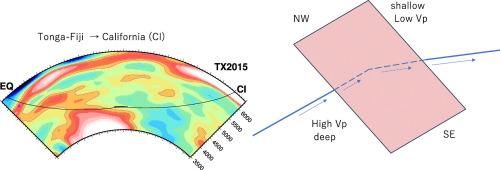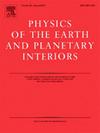中太平洋下中下地幔地震反射体:与太平洋LLSVP的关系
IF 1.9
3区 地球科学
Q2 GEOCHEMISTRY & GEOPHYSICS
引用次数: 0
摘要
P尾区的地震信号来源于深部地幔非均质性,除了推测在D″层顶部反射的波外,尚未得到广泛的研究。我们在本研究中表明,对南加州地震仪台网记录的汤加-斐济和所罗门群岛深地震的地震图进行阵列处理后发现,在直接P波后5至10秒,P波尾强烈的非大圆到达。我们还表明,汤加-斐济事件观测到的大到达波是太平洋中部下地幔倾斜界面上的P-to-P反射波。反射面位于夏威夷东南偏南,深度约2000公里,向东南方向倾斜近35°。如果反射器下侧的Vp比上侧快1 ~ 2%,就可以解释反射波的振幅和极性。小的Vp异常不一定与以前的地震层析成像模型在反射器位置没有明显的Vp异常相矛盾。我们还发现,反射波与靠近震源近1000公里的中地幔散射物体的较弱到达近似伴随。引起所罗门群岛事件异常到达的异质物体,虽然其性质不像汤加-斐济反射器那样受到很好的约束,但也可能代表位于夏威夷热点大约下方2400公里处的另一个倾斜反射器。就像汤加-斐济的情况一样,在这些信号之后,偶尔会有来自靠近震源的中地幔散射物体的较弱信号。中地幔反射/散射对象不能表明全球不连续性的存在,而必须代表局部强非均质性。值得注意的是,局部非均质分布都位于全球层析成像分辨出的一个大型低v体(太平洋LLSVP)的边缘附近,距离LLSVP本身高达500 km。反射体/散射体的位置与大尺度Vp结构之间的关系尚不清楚,可能反映了与LLSVP相关的Vp结构较差的断层扫描图像。我们讨论了这些中地幔非均质性对LLSVP构造和演化的可能的构造意义。本文章由计算机程序翻译,如有差异,请以英文原文为准。

Seismic reflectors in the mid-lower mantle beneath central Pacific: The relationship with the Pacific LLSVP
Seismic signals in P coda originating from deep mantle heterogeneity have not yet been investigated extensively, except for the observations of the waves reflected presumably at the top of the D″ layer. We show in this study that array processing of seismograms of deep earthquakes at Tonga-Fiji and Solomon Islands recorded by seismograph networks at southern California reveals strong off-great circle arrivals in P coda 5 to 10 s after direct P waves. We also show that the large arrivals observed for the Tonga-Fiji events are P-to-P reflected waves at a dipping interface in the mid-lower mantle beneath central Pacific. The reflector is located south-southeast of Hawaii around 2000 km depth and dips down to southeast by nearly 35°. The observed amplitude and polarity of the reflected waves could be explained if the Vp of the underlying side of the reflector is 1 to 2 % faster than the overlying side. The small Vp anomaly may not necessarily contradict the absence of a noticeable Vp anomaly in previous seismic tomography models at the site of the reflector. We also find that the reflected wave is approximately concomitant with a weaker arrival from a mid-mantle scattering object located nearly 1000 km closer to the hypocenters. The heterogeneous object causing the anomalous arrivals for the Solomon Islands events, although the properties of the object are less well constrained than the Tonga-Fiji reflector, also likely represents another dipping reflector at 2400 km located approximately below the Hawaiian hotspot. As in the Tonga-Fiji case the signals are occasionally followed by a weaker signal from a mid-mantle scattering object located nearer to the hypocenters. The mid-mantle reflection/scattering objects do not indicate the presence of a global discontinuity but must represent localized strong heterogeneities. It is notable that the localized heterogeneities are all located near the edges of a large low Vs body (the Pacific LLSVP) resolved by global tomography, up to 500 km above the LLSVP itself. The relation between the locations of the reflector/scatterers and the large scale Vp structure is unclear, probably reflecting poorer tomography images of Vp structure associated with the LLSVP. We discuss possible tectonic implications of these mid-mantle heterogeneities on the structure and evolution of the LLSVP.
求助全文
通过发布文献求助,成功后即可免费获取论文全文。
去求助
来源期刊

Physics of the Earth and Planetary Interiors
地学天文-地球化学与地球物理
CiteScore
5.00
自引率
4.30%
发文量
78
审稿时长
18.5 weeks
期刊介绍:
Launched in 1968 to fill the need for an international journal in the field of planetary physics, geodesy and geophysics, Physics of the Earth and Planetary Interiors has now grown to become important reading matter for all geophysicists. It is the only journal to be entirely devoted to the physical and chemical processes of planetary interiors.
Original research papers, review articles, short communications and book reviews are all published on a regular basis; and from time to time special issues of the journal are devoted to the publication of the proceedings of symposia and congresses which the editors feel will be of particular interest to the reader.
 求助内容:
求助内容: 应助结果提醒方式:
应助结果提醒方式:


